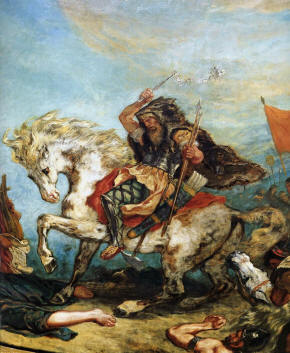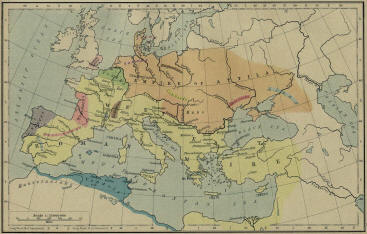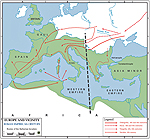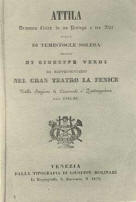|

ATTILA - PAINTING BY
EUGENE DELACROIX
Attila the Hun ...-453
|
|
Image above:
Detail from the painting Attila and his
Hordes Overrun Italy and the Arts.
Painter: Eugene
Delacroix, who created this artwork 1843-1847. |
Attila, king of the Huns, was nicknamed
the Scourge of God,
in Latin: Flagellum Dei. As the nickname indicates, Attila was rather
the assertive type.
 Priscus of
Panium described Attila as a short man
with a large head, deep-set eyes, flat nose, and a thin beard.
Priscus of
Panium described Attila as a short man
with a large head, deep-set eyes, flat nose, and a thin beard.
Attila the King
Attila's uncle Rua, or
Rugila, ruled the Huns until
his death in 434.
Attila then ruled from 434 to 453.
During his reign however, Attila had a co-ruler. His elder brother
Bleda ruled with him from 434 until 445.
In 445 the partnership was dissolved when Attila
murdered Bleda.
Attila's wife was
Hereka.
 Who in the world were the Huns?
Who in the world were the Huns?
Attila's Empire
Attila and Bleda inherited an empire that already posed a threat to
neighboring nations. Under Attila's rule it expanded even
further. See map below.

ATTILA'S EMPIRE IN
450
Click to enlarge
The Roman Empire in Attila's Days
While Attila roamed the earth, the Roman Empire was split into the
 East Roman
Empire and the East Roman
Empire and the
 West Roman Empire. West Roman Empire.
The emperor of the Eastern Roman Empire was
 Theodosius II and
the emperor of the Western Roman Empire was Valentinian III. Theodosius II and
the emperor of the Western Roman Empire was Valentinian III.
Ever since the Huns had defeated the
 Visigoths in 376, and
had arrived knocking at the
doors of the Eastern Roman Empire, the Romans paid the Huns good
money to be left in
peace. Visigoths in 376, and
had arrived knocking at the
doors of the Eastern Roman Empire, the Romans paid the Huns good
money to be left in
peace.
In 435, Attila, Breda, and Theodosius II
renewed the agreements and signed a further peace treaty, the
Treaty of Margus. Margus is
today's Passarowitz (think
 Treaty of
Passarowitz), or also called Pozarevac. It is located in Serbia
and also home town of late Slobodan Milosevic. Treaty of
Passarowitz), or also called Pozarevac. It is located in Serbia
and also home town of late Slobodan Milosevic.
Back to Attila.
The Treaty of Margus stated that the Huns would not
attack the Romans if the latter would pay double the money they had
paid previously.
The Romans didn't pay up and the Huns
attacked in 441. The Balkan was invaded and Belgrade was
sacked. The attacks continued. In 443 Sofia was sacked and
Attila camped in front of Constantinople's gates. Theodosius II was
obliged to agree to yet another treaty in 443, which tripled his
payments.
In 447, Attila raided the East Roman Empire again. This time he went
all the way down to Thermopylae. The stipulations of the
following peace treaty topped even the previous treaty. Theodosius
II did the only decent thing he could think of doing and died in
450.
Theodosius II's successor,
Marcian,
categorically refused to pay anything at all and Attila, presently preoccupied by
preparations to invade Gaul, made a little note in his calendar to
have Marcian for breakfast at a more opportune time.
Attila and Honoria
Honoria was the sister of Emperor
Valentinian III,
ruler of the Western Roman Empire.
In the year 450, Honoria or somebody who
had access to Honoria's jewel box, sent Honoria's ring to Attila.
The attached message read roughly summed up, "My name is Honoria and
I'm desperate. Please rescue me from a marriage that has been
arranged for me."
Attila, ever so fond of foolish
mistakes made by the enemy, officially declared Honoria his wife and ordered
the Western Roman Emperor to cede half the empire as Honoria's dowry.
Valentinian III cursed the day his
sister was born and refused to cede anything.
Attila made another note in his
calendar.
Attila in Gaul and
Italy
Attila invaded Gaul in 451, which the Western Roman Empire felt was
awfully close to home. However, Attila's official reason for this
invasion were "just the Visigoths." He claimed to have no beef with
the Western Romans.
But who could be so sure these days,
especially with Atilla's demand of half of the Western Roman Empire
still in the air.
So the Visigoths, led by Theodoric I, and the Romans, led by
Flavius Aetius, joined forces and defeated Attila at the
 Battle of the Catalaunian Plains in 451. Battle of the Catalaunian Plains in 451.
This was Attila's only defeat and he didn't like it. He went on to
invade northern Italy in 452. He sacked Padua, Verona, Bergamo, and
Milan, and was fixing to pay Rome a visit. But food shortage, disease,
and Pope Leo I changed his mind.
Attila's Death
Attila checked his calendar and remembered Marcian, the Eastern Roman Emperor. Collecting his
debts was next on the list but first things first.
There was the girl
Ildico who
was ready to get married and Attila arranged things accordingly. Attila
died on his wedding night allegedly of a nasal hemorrhage. I know
what you think but hey.
Supposedly the folks who buried Attila
were killed right after the burial to ensure that nobody would ever find
Attila's grave.
How Big Was Attila's
Army?
On his attack on Gaul, Attila commanded approximately 500,000 men.
For the route of Attila, check this map

ROUTE OF ATTILA
Click map to enlarge
Attila's Legacy
After his death Attila's empire was divided among Attila's sons. But
it went downhill with the Huns thenceforward.
In 455, the combined
forces of several enemy tribes defeated the Huns at what is today
approximately western Hungary.
The Huns' heyday was officially over.

Roman Empire 5th Century: Routes of the Barbarian Invaders
Attila the
Legend
The Nibelungenlied, or
Song of the Nibelungs, is a
German epic poem written around the year 1200. It features
Etzel,
king of the Huns, who is Attila.
Attila Facts and
Trivia
Giuseppe Verdi was 33 years old when he composed the opera
Attila in 1846. For
 more info on the opera
Attila go here. more info on the opera
Attila go here.

VERDI'S OPERA ATTILA
In 1954, two Attila movies came out at
the same time,
 Attila
and Attila
and
 Sign of
the Pagan Sign of
the Pagan
Check the links for video clips and stuff.
More History
|